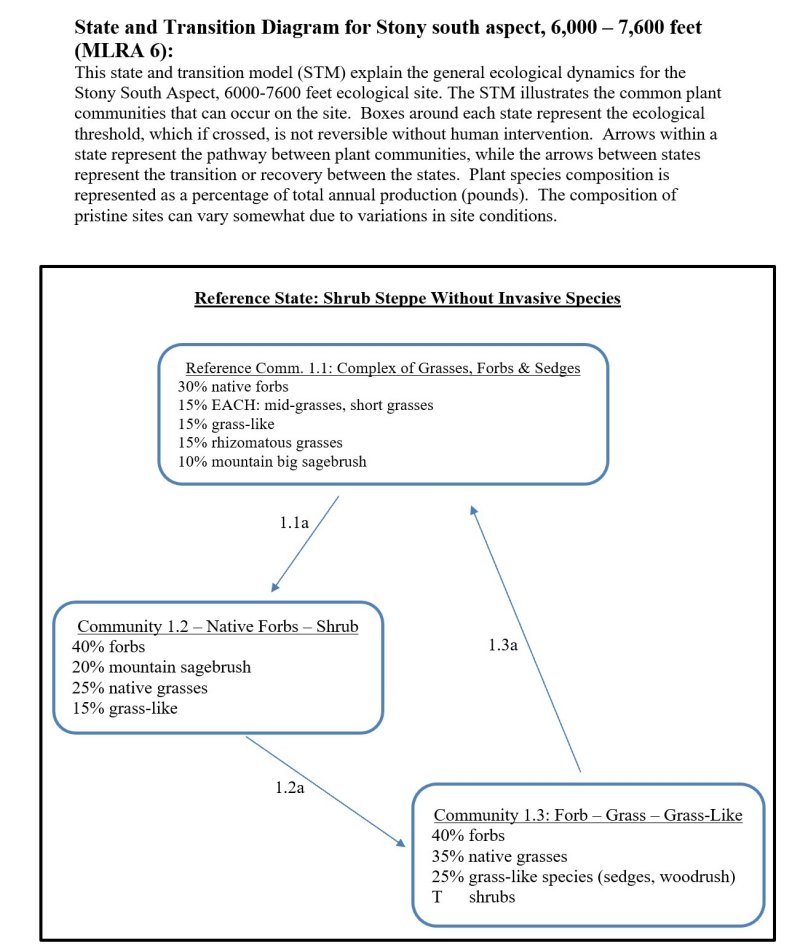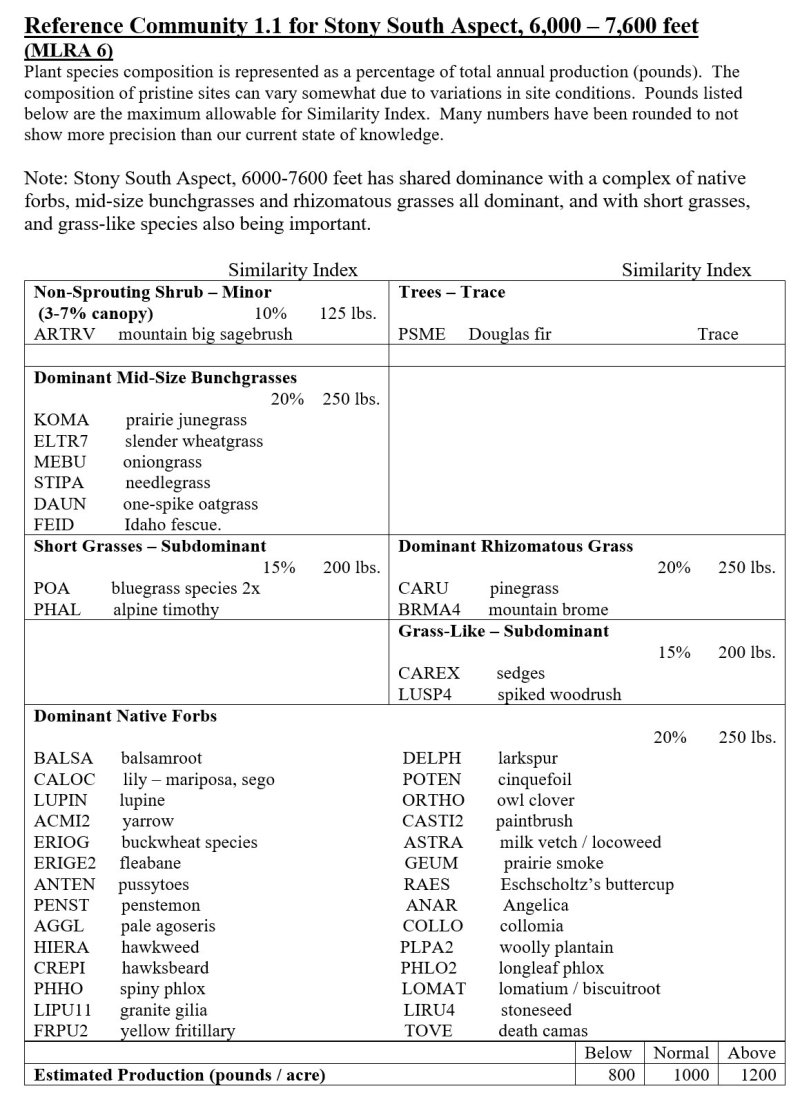Ecological site group R006XG165WA
Stony south aspect, 6000-7600 feet
Last updated: 09/21/2023
Accessed: 12/21/2025
Ecological site group description
Key Characteristics
None specified
Provisional. A provisional ecological site description has undergone quality control and quality assurance review. It contains a working state and transition model and enough information to identify the ecological site.
Physiography
Hierarchical Classification
Major Land Resource Area (MLRA): 6 – Cascade Mountains, East Slope
Land Resource Unit (LRU) – Common Resource Areas (CRA):
6.1 – North Cascades Subalpine/Alpine
6.2 – Pasayten/Sawtooth Highlands
6.3 – Okanogan Pine/Fir Hills
6.4 – Chelan Tephra Hills
6.5 – Chiwaukum Hills and Lowlands
Site Concept Narrative:
Diagnostics:
More than 80% of the landscape of MLRA 6 is forest. This site stands out because of a lack of trees.
Stony south aspect, 6,000 – 7,600 feet is an upland site at high elevations (6000-7600 feet) in the 25-35-inch precipitation zone in MLRA 6. This site is found on southeast and south to west aspects. Level areas and other aspects are forest. The soils are generally deep and stony. Sandy loam and loam are the main textures.
Stony south aspect, 6,000 – 7,600 feet is shrub steppe. This site is not dominated by one or two species like most ecological sites. Instead, dominance is shared by a complex of species – grasses, forbs, and grass-like species. Native forbs (especially lupine, buckwheat, paintbrush, yarrow), rhizomatous grasses (pinegrass, mountain brome), and mid-size bunchgrasses (prairie junegrass, slender wheatgrass, oatgrass, oniongrass) are co-dominant, while grass-like species (sedges and spiked woodrush), and short grasses (bluegrass species, alpine timothy), are also important to the reference plant community. The shrub layer is dominated by mountain sagebrush
Principle Vegetative Drivers:
The vegetative expression of this ecological site is driven by the combination of four factors:
(1) Elevation between 6,000 and 7,600 feet and correspondently short growing season
(2) 25-40 inches of precipitation
(3) The southeast, and south to west aspects
(4) Moderately deep to deep soils provide unrestricted rooting for most species
(5) Timing and amount of late-May and June precipitation
Influencing Water Features:
A plant’s ability to grow on a site and overall plant production is determined by soil-water-plant relationships
1. Whether rain and melting snow runs off-site or infiltrates into the soil
2. Whether soil condition remain aerobic or become saturated and become anaerobic
3. Water drainage and how quickly the soil reaches wilting point
With adequate cover of live plants and litter, there are no restrictions on Loamy sites with water infiltrating into the soil. These sites are well drained and are saturated for only a short period.
Physiography of MLRA 6:
Most of MLRA 6 is in the Northern and Middle Cascade Mountains. This mountainous area consists of sharp alpine summits with some higher volcanic cones to the west, and lower lying foothills to the east. Strongly sloping mountains and U-shaped valleys are dominant in the north, with eroded basalt plateaus more typical in the south. The East Slope of the Cascades is a transitional area between the moist, rugged Cascade Mountains to the west and the drier, lower lying Columbia Basalt Plateau to the east. MLRA 6 has some of the landforms typical of both mountains and plateaus.
Physiographic Division: Pacific Mountains
Physiographic Province: Cascade-Sierra Mountains
Physiographic Sections: Northern Cascade and Middle Cascade Mountains
Landscapes: Mountains
Landform: Sideslopes, shoulders, summits, benches
Elevation: Dominantly 5,000 to 8,400 feet
Central tendency: 6,000 to 7,600 feet
Slope: Total range: 2 to 90 percent
Central tendency: 20 to 50 percent
Aspect: Dominantly occurs on southerly aspects
Geology:
MLRA 6 consists of Pre-Cretaceous metamorphic rocks cut by younger igneous intrusives. Tilted blocks of marine shale, carbonate, and other sediments occur in the far north, and some younger continental, river-laid sediments occur around Leavenworth, WA. Columbia River basalt is dominant in the southern portion of the state. Alpine glaciation has left remnants of glacial till, debris, and outwash in the northern part of this MLRA.
Climate
The climate across MLRA 6 is characterized by moderately cold, wet winters, and hot, dry summers, with limited precipitation due to the rain shadow effect of the Cascades. The average annual precipitation for most of the East Slope of the Cascades is 16-50 inches. Seventy-five to eighty percent of the precipitation comes late October through March as a mixture of rain and snow. The lowest precipitation occurs along the eastern edge, then increasing with rising elevation to the west. Most of the rainfall occurs as low-intensity, Pacific frontal storms during the winter, spring and fall. Rain turns to snow at the higher elevations. All areas receive snow in winter. Summers are relatively dry. The East Slopes experience greater temperature extremes and receive less precipitation than the west side of the Cascades. The shortest freeze-free periods occur along the western edge and the northern end of this MLRA, which are mountainous. The first snow generally comes by the 1st of September. Snowstorms through mid-October will melt but snow in late October and later stays.
Mean Annual Precipitation:
Range: 25-50 inches
Central tendency: 25 – 40 inches
Soil moisture regime is xeric
Mean Annual Air Temperature:
Range: 35 to 43 degrees
Central tendency: 38 to 41 degrees
Soil temperature regime is cryic
Frost-free period (days):
Total range: 50 to 90
Central tendency: 60 to 80
The growing season is early mid-June to early August.
Soil features
Edaphic:
Stony south aspect, 6,000 – 7,600 feet ecological site commonly occurs with Shallow Stony, 6,000 – 7,600 feet and subalpine fir ecological sites.
Representative Soil Features:
This ecological site components are dominantly Andic and Vitrixerandic taxonomic subgroup of Humicryepts and Cryumbrepts great groups of the Inceptisols. Soils are dominantly moderately deep and deep. Average available water capacity of about 3.5 inches (8.9 cm) in the 0 to 40 inches (0-100 cm) depth range.
Soil parent material is dominantly mixed volcanic ash in the upper part of the soil over colluvium and residuum.
The associated soils are Bagmont, Crocamp, Darland and similar soils.
Dominate soil surface is very gravelly ashy loam to stony sandy loam.
Dominant particle-size class is loamy-skeletal.
Fragments on surface horizon > 3 inches (% Volume):
Minimum: 0
Maximum: 10
Average: 1
Fragments within surface horizon > 3 inches (% Volume):
Minimum: 0
Maximum: 30
Average: 15
Fragments within surface horizon ≤ 3 inches (% Volume):
Minimum: 5
Maximum: 30
Average: 15
Subsurface fragments > 3 inches (% Volume):
Minimum: 10
Maximum: 50
Average: 30
Subsurface fragments ≤ 3 inches (% Volume):
Minimum: 10
Maximum: 50
Average: 25
Drainage Class: Well drained
Water table depth: Greater than 60 inches
Flooding:
Frequency: None
Ponding:
Frequency: None
Saturated Hydraulic Conductivity Class:
0 to 10 inches: Moderately high and high
10 to 40 inches: Moderately high and high
Depth to root-restricting feature (inches):
Minimum: 20
Maximum: Greater than 60
Electrical Conductivity (dS/m):
Minimum: 0
Maximum: 0
Sodium Absorption Ratio:
Minimum: 0
Maximum: 0
Calcium Carbonate Equivalent (percent):
Minimum: 0
Maximum: 0
Soil Reaction (pH) (1:1 Water):
0 - 10 inches: 5.1 to 7.3
10 - 40 inches: 5.6 to 7.3
Available Water Capacity (inches, 0 – 40 inches depth):
Minimum: 1.8
Maximum: 6.7
Average: 3.5
Vegetation dynamics
Ecological Dynamics:
Stony South Aspect, 6000-7600 feet produces about 800-1200 pounds/acre of biomass annually.
This site is not dominated by one or two species like most ecological sites. Instead, dominance is shared by a complex of species – grasses, forbs, and grass-like species. Native forbs (especially lupine, buckwheat, paintbrush, yarrow), rhizomatous grasses (pinegrass, mountain brome), and mid-size bunchgrasses (prairie junegrass, slender wheatgrass, oatgrass, oniongrass) share the dominant position, while short grasses (bluegrass species, alpine timothy), and grass-like species (sedges and spiked woodrush) are also important to the reference plant community. The shrub layer is dominated by mountain sagebrush
This complex of grasses, sedges and forbs provide a crucial and extensive network of roots to the soil profile. These roots create a massive underground source to stabilize the soils, provide organic matter and nutrients inputs, and help maintain soil pore space for water infiltration and water retention in the soil profile. The extensive rooting system of grasses, forbs and grass-like species fill the top two feet of the soil profile. The stability and resiliency of the reference communities is directly linked to this root-network.
At this elevation very few invasive grasses and broadleaf weeds are adapted, so altered states are not included in the State and Transition Model.
Stony South Aspect, 6000-7600 feet does not regularly burn in August and September as it is normally quite green during fire season. However, the mountain sagebrush, which tend to increase over time, is quite susceptible to a sudden sharp drop in temperatures in late fall or early winter if not covered by snow. These events, very temperature dependent, will reduce a stand of mountain sagebrush to less than 5% canopy
Grazing pressure can be defined as heavy grazing intensity, or frequent grazing during reproductive growth, or season-long grazing (the same plants grazed more than once). Grazing pressure impacts Reference Community species composition.
The perennial bunchgrasses remain competitive if:
(1) Basal buds are replaced annually,
(2) Enough top-growth is maintained for growth and protection of growing points,
(3) Idaho fescue and other seeding grasses make viable seed and
(4) The timing of grazing and non-grazing is managed over a several-year period. Careful management of late spring grazing is especially critical
For more grazing management information refer to Range Technical Notes found in Section I Reference Lists of NRCS Field Office Technical Guide for Washington State.
In Washington, grass-forb-grass-like communities provide habitat for a variety of upland wildlife species.
Supporting Information:
Associated Sites:
Stony south aspect, 6,000 – 7,600 feet is associated with Shallow Stony 6000-7600 feet, Very Shallow and subalpine forest sites.
Similar sites:
Stony south aspect, 6,000 – 7,600 feet in MLRA 6 is similar in some respects and different in other respects.
Inventory Data References (narrative):
Data to populate Reference Community came from several sources: (1) NRCS ecological sites from 2004, (2) Soil Conservation Service range sites from 1980s and 1990s, (3) Daubenmire’s habitat types, and (4) ecological systems from Natural Heritage
Major Land Resource Area
MLRA 006X
Cascade Mountains, Eastern Slope
Stage
Provisional
Contributors
Provisional Site Author: Kevin Guinn Technical Team: W. Keller, K. Paup-Lefferts, R. Fleenor, K. Bomberger
Click on box and path labels to scroll to the respective text.

